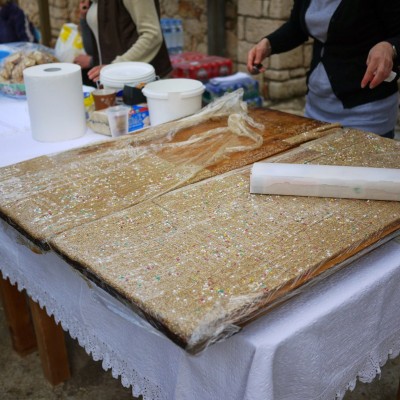Gastronomic tour of Zakynthos
Zakynthos is called “Hyliessa” according to Homer, that means covered in forests with mountainous and lowland areas, lush with olive trees and vineyards, with low mountains and endless beaches, shaped its cuisine based on the so-called Mediterranean diet.
Thus, Zakynthian cuisine is divided into three types: "Tsi Chora" (of the Down town), of Kampos and of the Mountains.
In Chora they used to eat more soups with some kind of pasta, with meat or without or from beef bones or from fish. Also marinated fish with garlic, ragout pasta, “aliada” (garlic paste), smashed potatoes, accompanied with cod or other fish, cold cuts and cheeses.
In Kampos and Rizohoria they ate more sauces with roosters or fresh chickens or stir fried vegetables, along with breaded “aliada”, local cheese and myzithra cheese and plenty of homemade wine.
In the mountains they fed on wild greens, hunting, mainly grilled, mushrooms, wine, local cheese like “pretza”, olives, wheat bread or corn. Their sauces were white because the soil was not suitable for planting tomatoes.
All over Zakynthos they eat rabbit sauce with pieces of local ladotyri cheese, eggs with tomato and fryssa, which is dried bread, soaked with tomato juice and sprinkled with oregano, coarse salt and accompanied with traditional pretza, a kind of liquid sour cheese.
The Zakynthian calendar, which is very rich and includes dozens of known and unknown celebrations, has organized around food and many new recipes, which we find both in the houses and in the seaside tourist taverns.
The festive food of the Zakynthians was the egg-lemon sauce. This soup was usually cooked at Christmas, New Year's and Fota celebration. To make the egg-lemon sauce, boil the turkey meat along with beef and pork. The amount of eggs depends on the people that will eat.
In the oven they baked a turkey on the second day of Christmas (of the Virgin Mary) and St. John (the next day from the Epiphany celebration). They filled it with a spicy filling consisting of the bird's innards, stale bread, ladotyri cheese, salt and pepper and garlic, and baked it in the oven with potatoes. In hunters' homes they used to stuff whole “tsixles” which is a small bird species.
The great celebration of Christmas, in addition to the priestly acts that took place and still take place in the churches, is also associated with customs that are different from the other place in Greece. The most characteristic is perhaps the cut of the kouloura, which takes place on the eve of the feast. Kouloura is a bread whose flour is fermented with wine, olive oil, sugar, orange and mandarin peel chunks, anise, finely chopped almonds, raisins and cinnamon carnations.
The typical Easter dish is ham, the preparation of which starts from December to January. It is prepared in two ways: salted and baked in the sun, which is made with pork leg and cut into thin slices, and the ham of the basket, which is made with pork pancetta, which is wrapped in layers in a basket. The first is found in lowland areas, while the second in mountainous areas. The other ingredients are: black pepper, coarse salt, rosemary, garlic, nutmeg and bay leaves.
The same is true for sweets, the best known of which are the mandolin and the pasteli.
The mandolin, is a sweet brought by the Venetians in Zakynthos and takes its name from its main ingredient, the "almond", which is Italian called "mandola". Contains almonds, honey, egg white and a small amount of sugar. They offered it at the engagement parties, weddings, christenings and Halloween season.
Due to the fact that the Venetians had planted many almond trees in Zakynthos, they also made the famous mandolas, a sweet made from almonds, roasted with honey and sprinkled with cinnamon.
The most famous dessert of Zakynthos, which we find sold at the festivals is the pasteli. Its ingredients: sesame, honey and almond.
Famous dessert, usually given as a treat at weddings was the pantola, a fluffy cake, with rosewater syrup, sprinkled with powdered sugar. It was always accompanied by sumada, a soft drink made from almond kernels, a few bitter almonds and rosewater.
In the local festivals “panigyria” we also find the traditional sweet f(r)ytoura, which is a thick cream made of semolina and water, cut into pieces, fried and offered sprinkled with sugar and cinnamon.
A similar sweet to the fytoura is the cornbread, made with corn flour, sugar, cinnamon carnations, cognac, flavored with orange peel, baked in the oven on a flat baking pan and cut into pieces.
Corn flour, too, on winter evenings, made “kalampomagerema” corn cooking, which was a cream made with warm water, a little oil, salt and several local black raisins and served on deep plates and sprinkled with sugar.
All the houses of Zakynthos always had a jar with “spoon sweets”, most commonly grapes (mainly sultanas), quince, fig, citrus and lemon the "foulariko" (grape). These are fruits cooked and covered in syrup.
They also made liqueurs – liqueurs from fruit (pomegranate), usually from citrus fruits (lemon) and nuts (walnut, almond).
From the grape must also derived the “pittimezi” molasse, which they used to make many desserts sush as moustalevria, the melachrino, the moustokouloura, the moustokydono.
A popular dessert of the last decades, offered in the restaurants of the island, is the famous toast, which consists of a layer of toast dipped in syrup, a layer of cream, a layer of whipped cream sprinkled with grated, roasted almonds, and cherry or sour cherry syrup.
Wine is also used in cooking, as in marinades and meat. The dry white wine accompanies the traditional specialties of the island and the seafood, red and black meats on the grill and the dish of traditional cheeses.

